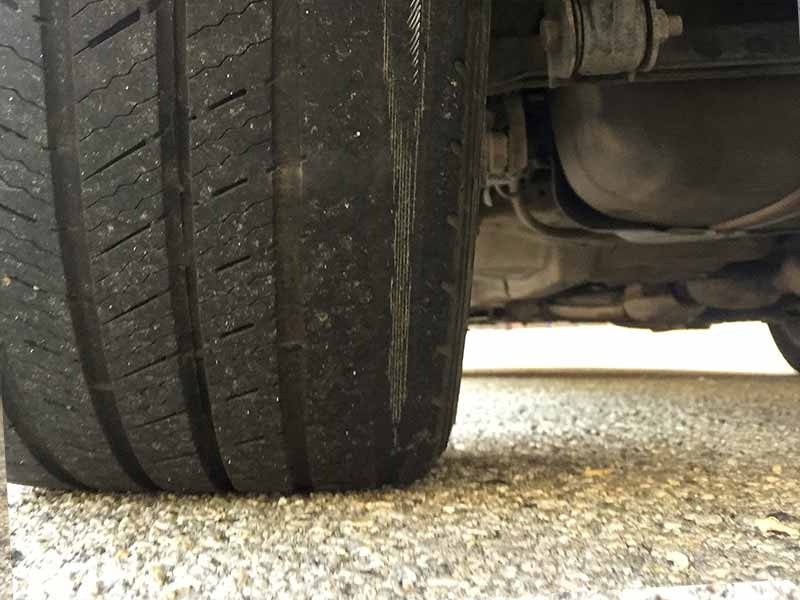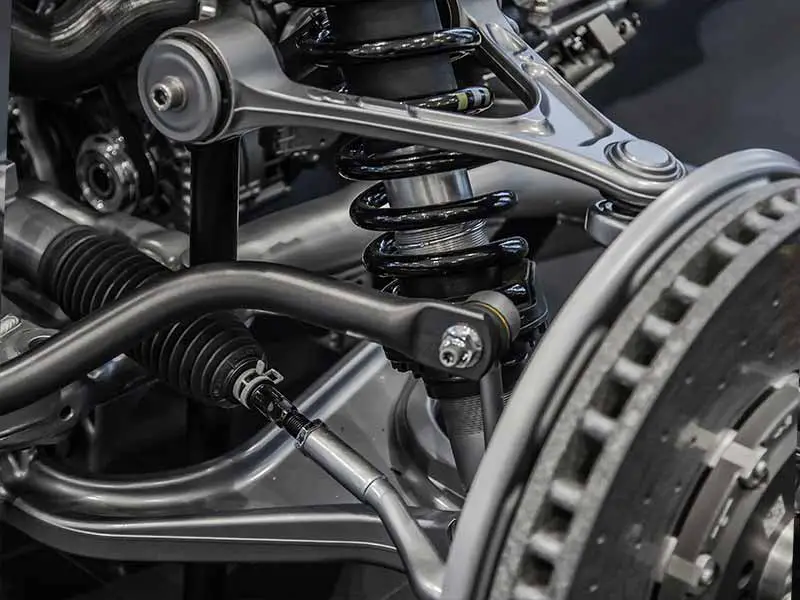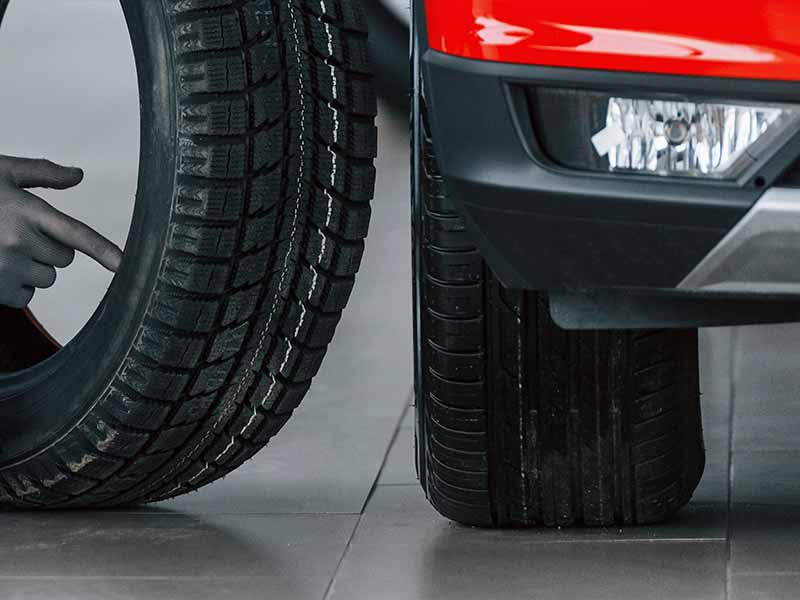Have you noticed your front tires wearing down on the inside, while the rest of the tire looks just fine? Well, you’re not alone. This is a common issue for many drivers, and if left unaddressed, it can lead to bigger problems down the road (pun intended!).
Front Tires Wearing On Inside Only
Front tires wearing only on the inside is often due to wheel misalignment, worn out suspension components, or incorrect tire pressure.
Addressing these issues by aligning wheels, replacing worn-out components, and maintaining proper tire pressure can fix this problem.
In this article, we’ll guide you through the causes of uneven inside tire wear, discuss the role of different vehicle components, and explore scenarios like single-tire wear. You’ll learn about terms like toe out, negative camber, and the role they play in tire wear. We’ll share practical steps to fix inner tire wear and talk about the potential dangers if left unaddressed.
Let’s take a closer look.

Common Causes of Inner Front Tire Wear
Let’s get down to business and discuss what might be causing it. A few different things can contribute to your tires wearing out more on the inside edge, just like how a detective looks for different clues to solve a mystery.
Misalignment: The Usual Suspect
The number one suspect in our inner tire wear investigation is wheel alignment. Picture this – you’re trying to push a shopping cart straight ahead, but one of the wheels keeps pulling to the side. That’s pretty much what misalignment is like for your car.
When your wheels aren’t aligned correctly, it can cause the tires to angle a bit and touch the road unevenly. If they’re angled so the inside edges touch the road more, you guessed it – that can lead to inner tire wear.
Underinflation: The Silent Saboteur
Another common culprit is underinflation. We touched on this earlier, but if your tires aren’t inflated enough, they can squash out and make the edges – including the inside edges – touch the road more than they should. This is one reason why checking your tire pressure regularly is super important.
Worn Ball Joints: Hidden Troublemakers
Here’s where we dive a bit deeper into the mechanics of your vehicle. Ball joints are like the shoulder joints in your body – they let your car’s wheels and suspension move together. When they’re worn out, they can cause your wheels to angle inward, leading to – you’ve got it – inner tire wear.
Damaged Suspension Components: The Unsung Villains
Last but not least, other damaged suspension components can also play a role. The suspension is what connects your vehicle to its wheels and helps manage the way it moves. If parts of the suspension are worn or damaged, it can mess with your wheel alignment and tire pressure, and we already know how those can contribute to inner tire wear.
Case Scenario: When Only One Tire is Wearing on the Inside
One of your tires is wearing on the inside, but the others are perfectly fine? Let’s diagnose why this can happen.
A One-Tire Mystery
So, why might only one tire be showing signs of inner wear? While it might seem weird, there are a few explanations for this one-tire mystery.
The Case of the Damaged Component
The most likely cause is that there’s a damaged or worn-out component on that specific wheel. Maybe it’s a worn-out ball joint, or a damaged part of the suspension, causing that wheel to angle inward and wear on the inside edge. Like a bad apple in a bunch, one faulty component can cause trouble in an otherwise perfectly fine system.
The Mystery of Misalignment
Another potential cause could be a wheel alignment issue specific to that wheel. Just like how a wobbly table can be fixed by adjusting one leg, sometimes only one wheel of your car needs a realignment. This could happen due to hitting a large pothole, for example, which can knock your wheel out of alignment.

The Role of Suspension Components and Ball Joints
Think of your car like a big, complicated puzzle. Each piece plays an important role in making the whole thing work smoothly, and if one piece isn’t fitting right, it can mess up the entire picture. Two of these puzzle pieces are the suspension components and the ball joints.
Suspension Components: The Silent Protectors
The suspension components are what connect your vehicle to its wheels. They have to absorb all the bumps and jolts from the road to keep your ride smooth and your wheels in contact with the road. You can think of them as the shock absorbers when you’re bouncing on a trampoline – without them, you’d feel every single jolt.
If these components get damaged or worn out, they can’t do their job properly, which can lead to a whole host of problems, including uneven tire wear. Damaged suspension components might not hold the wheel correctly, causing it to angle inward and wear more on the inside edge.
Ball Joints: The Hidden Workhorses
Next up, we’ve got the ball joints. These little guys are part of your car’s suspension system, and they work like the joints in your body, allowing different parts to move together. They’re like the shoulders or hips of your car, letting your wheels and suspension move as one.
When the ball joints are in good shape, they keep everything moving smoothly. But when they’re worn out, they can cause your wheels to angle inward, leading to inner tire wear.
The Importance of Regular Check-Ups
Just like how you need to visit a doctor for a check-up even when you’re feeling okay, your car also needs regular check-ups to catch any issues before they become major problems. Things like worn control arm bushings, a part of your car’s suspension system, can be spotted and fixed before they lead to uneven tire wear.
Wheel Alignment: Toe Out and Negative Camber Wear
Navigating the world of tire wear can feel a bit like trying to decode a secret language, with all the technical terms and jargon. We’re going to crack the code, starting with two terms you might have come across – “toe out” and “negative camber.”
Toe Out: The Sideways Shuffle
Imagine you’re standing up straight and point your toes outward, away from each other – that’s basically what “toe out” means for your car’s wheels. Instead of pointing straight ahead, the wheels are angled slightly outward.
While a bit of toe out can be helpful for things like cornering, too much of it can lead to the inner edges of your tires touching the road more than they should, leading to – you guessed it – inner tire wear.
Negative Camber: The Leaning Tower
Now, let’s think about the Leaning Tower of Pisa. You know how it tilts to one side? That’s pretty much what negative camber is for your wheels – they’re tilted slightly inward. Just like the toe out, a bit of negative camber can be beneficial for handling your car, but too much can cause the inside edges of your tires to wear out quicker.
Rear Tires: The Backseat Drivers
When it comes to tire wear, the rear tires often take a backseat (pun totally intended!). However, they too can show signs of uneven wear due to factors like toe out and negative camber, especially in vehicles with rear-wheel drive or all-wheel drive. So, don’t forget to give your rear tires some love too when you’re checking for tire wear.
How to Fix Inner Tire Wear
We’ve taken a good look at what causes inner tire wear and the role of different components. Now, it’s time to roll up our sleeves and get into the nitty-gritty of fixing this issue. Don’t worry, you don’t need to be a professional mechanic to handle this. A little bit of know-how and some regular maintenance can go a long way in keeping your tires in tip-top shape.
Keep an Eye on Tire Pressure
Remember, tire pressure is a big deal when it comes to tire wear. Make sure your tires are properly inflated – not too much, not too little, but just right. Checking your tire pressure regularly is an easy and effective way to prevent uneven tire wear.
Regular Wheel Alignment Checks
Think of wheel alignment like getting a haircut – it’s not a one-and-done deal. Just like how your hair keeps growing, your wheel alignment can get out of whack over time or if you hit a pothole or curb. Regular wheel alignment checks can help catch any issues early and keep your tires wearing evenly.
Inspect Suspension Components and Ball Joints
Don’t forget about your car’s suspension components and ball joints. If these are worn out or damaged, they can lead to inner tire wear. A professional can help inspect these components and replace them if necessary.
Rotate Your Tires
Rotating your tires is another effective way to prevent uneven wear. By swapping your tires around, you can help them wear more evenly and extend their lifespan. Remember, your front tires bear more of your vehicle’s weight and do more work when you’re turning, so they tend to wear out quicker.
Regular Professional Inspections
While there’s a lot you can do on your own, having a professional inspect your vehicle can help catch any issues you might miss. They can check things like your suspension components, ball joints, and wheel alignment, and fix any problems.
Resources
Below are some links you may find helpful when learning about tires
- What causes tires to wear on the inside? – Get Jerry
- How to read tire wear patterns & improve your safety – Firestone
Final Thoughts
Uneven tire wear, particularly on the inner side of front tires, isn’t something to brush off as a minor annoyance. It’s a sign that something might be off with your vehicle – whether it’s misaligned wheels, incorrect tire pressure, worn-out suspension components, or damaged ball joints.
Taking steps to maintain correct tire pressure, ensuring regular wheel alignment checks, inspecting and replacing worn-out suspension components and ball joints, and not forgetting regular tire rotation can significantly extend the life of your tires. Remember, this isn’t just about saving money or the hassle of getting new tires – it’s about your safety on the road.
Good luck and happy motoring.




